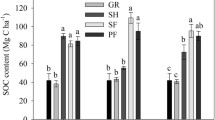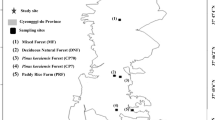Abstract
It is well known that land use change can affect soil C storage of terrestrial ecosystems either by altering the biotic processes involved in carbon cycling or by altering abiotic processes such as carbon adsorption on soil minerals. Relatively few studies, however, have examined the dynamics of soil C pools after conversion of farmland to forest or pasture. We selected three pairs of secondary forests and pastures that originated from the same abandoned sugarcane (interspecific hybrids of Saccharum spp.) land in the wet tropics of Hawaii to examine whether forest or pasture converted from farmland is more effective in sequestering C in soils. We compared the soil C pool, soil chemistry, and stable C isotope ratios between the forests and pastures. We found that total soil C was greater (P < 0.01) in forests than in the pastures 22 years after land conversion. The percentages of SOC4 in the pastures were significantly higher than in the secondary forests in both soil layers. The percentages of SOC3 in the pastures were lower than in the secondary forests in both soil layers. The net SOC3 increase in the forest soils at 0–10 and 10–25 cm was 28.6 ± 5.6 and 43.9 ± 3.2 Mg ha−1 while net SOC4 increase in pasture soils at these respective depths was 18.8 ± 2.2 and 26.1 ± 2.7 Mg ha−1. We found that the net increases of SOC3 in both soil layers in the forest were greater (P < 0.01) than the net increases of SOC4 in the respective soil layers in the pasture. Aluminum saturation was greater (P < 0.01) in the forests than the pastures in both soil layers. There was no difference in oxalate extractable Fe concentration between the forests and the pastures but oxalate extractable Al concentration in both soil layers was greater (P < 0.05) in forests than the pastures. Our findings indicated that reforestation of abandoned sugarcane farmland in Hawaii is more effective in soil C increase and stabilization than conversion to pasture.



Similar content being viewed by others
References
Amezquita MC, Amezquita E, Casasola F, Ramirez BL, Giraldo H, Gomez ME, Llanderal T, Velazquez J, Ibrahim MA (2008) C stocks and sequestration. In: Mannetje L’t, Amezquita MC, Buurman P, Ibrahim MA (eds) Carbon sequestration in tropical grassland ecosystems. Wageningen Academic, Netherlands
Bashkin MA, Binkley D (1998) Changes in soil carbon following afforestation in Hawaii. Ecology 79:828–833
Binkley D, Resh SC (1999) Rapid changes in soils following Eucalyptus afforestation in Hawaii. Soil Sci Soc Am J 63:222–225
Brown S (1998) Present and future role of forests in global climate change. In: Gople B, Pathak PS, Saxena KG (eds) Ecology today. International Scientific Publication, New Delhi, pp 59–94
Brown S, Lugo AE (1990) Tropical secondary forests. J Trop Ecol 6:1–32
Brown S, Sathaye J, Cannell M, Kauppi P (1996) Management of forests for mitigation of greenhouse gas emissions. In: Watson RT, Zinyowera MC, Moss RH (eds) Climate Change 1995: impacts, adaptations and mitigation of climate change: scientific-technical analyses). Cambridge University Press, Cambridge, pp 773–797
Cerri CC, Volkoff B, Andreux F (1991) Nature and behaviour of organic matter in soils under natural forest, and after deforestation, burning and cultivation, near Manaus. For Ecol Manage 38:247–257
Chone T, Andreux F, Correa JC, Volkoff B, Cerri CC (1991) Changes in organic matter in an oxisol from the central Amazonian forest during eight years as pasture, determined by 13C composition. In: Berthelin J (ed) Diversity of environmental biogeochemistry. Elsevier, New York, pp 307–405
Conant RT, Paustian K, Elliot ET (2001) Grassland management and conversion into grassland: effects on soil carbon. Ecol Appl 11:343–355
Dahlgren RA, Saigusa M, Ugolini FC (2004) The nature, properties and management of volcanic soils. Adv Agron 82:113–182
Del Galdo I, Six J, Peressotti A, Cotrufo MF (2003) Assessing the impact of land-use change on soil C sequestration in agricultural soils by means of organic matter fraction and stable C isotopes. Glob Chang Biol 9:1204–1213
Detwiler RP (1986) Land use change and the global carbon cycle: the role of tropical soils. Biogeochemistry 2:67–93
Dewar RC, Cannell MGR (1992) Carbon sequestration in the trees, products and soils of forest plantations: an analysis using UK examples. Tree Physiol 11:49–71
Dixon RK, Brown S, Houghton RA, Solomon AM, Trexler MC, Wisniewski J (1994) Carbon pools and fluxes of global forest ecosystems. Science 263:185–190
Eastham J, Rose CW (1990) Tree/pasture interactions in a range of tree densities in an agroforestry experiment. 1. Rooting patterns. Aust J Agric Res 41:683–695
Feldpausch TR, Rondon M, Fernandes ECM, Riha SJ (2004) Carbon and nutrient accumulation in secondary forests regenerating from pastures in central Amazônia. Ecol Appl 14(Supplement):S164–S176
Giardina CP, Binkley D, Ryan MG, Fownes JH, Senock RS (2004) Belowground carbon cycling in a humid tropical forest decreases with fertilization. Oecologia 139:545–550
Guo LB, Gifford RM (2002) Soil carbon stocks and land use change: a meta analysis. Glob Chang Biol 8:345–360
Houghton RA, Hackler JL, Lawrence KT (1999) The US carbon budget: contributions from land-use change. Science 285:574–578
Houghton RA, Skole DL, Nobre CA, Hackler JL, Lawrence KT, Chmentowski WH (2000) Annual fluxes of carbon from deforestation and regrowth in the Brazilian Amazon. Nature 403:301–304
Hu S, Chapin FS III, Firestone MK, Field CB, Chiariello NR (2001) Nitrogen limitation of microbial decomposition in a grassland under elevated CO2. Nature 409:188–191
Hue NV, Uchida R, Ho MC (2000) Sampling and analysis of soils and plant tissues: how to take representative samples, how the samples are tested. In: Silva JA, Uchida RS (eds) Plant nutrient management in Hawaii=s soils: approaches for tropical and subtropical agriculture. CTAHR, Univ. of Hawaii, Manoa, pp 23–30
Hughes RF, Kauffman JB, Jaramillo VJ (1999) Biomass, carbon, and nutrient dynamics of secondary forests in a humid tropical region of Mexico. Ecology 80:1892–1907
IPCC (2000) In: Watson RT, Noble IR, Bolin B, Ravindranath NH, Verardo D, Dokken D (eds) Lnad use, land-use change and forestry: a special report of the international panel on climate change. Cambridge University Press, Cambridge
Kelly EF, Chadwick OA, Hilinski TE (1998) The effect of plants on mineral weathering. Bioegeochemistry 42:21–53
Kimble JM, Heath LS, Birdsey RA, Lal R (2003) The potential of U.S forest soils to sequester carbon and mitigate the greenhouse effect. CRC, New York
Li Y, Xu M, Zou X, Shi P, Zhang Y (2005) Comparing soil organic carbon dynamics in plantation and secondary forest in wet tropics in Puerto Rico. Glob Chang Biol 11:239–248
López-Ulloa M, Veldkamp E, de Koning GHJ (2005) Soil carbon stabilization in converted tropical pastures and forests depends on soil type. Soil Sci Soc Am J 69:1110–1117
Mahilum BC (2004) Basic soil science and concepts in tropical soils. Trop Ag Hawaii, Inc., Honokaa
Marín-Spiotta E, Swanston CW, Silver WL, Torn MS, Burton SD (2008) Chemical and mineral control of soil carbon turnover in abandoned tropical pastures. Geoderma 143:49–62
Marín-Spiotta E, Silver WL, Swanston CW, Ostertag R (2009) Soil organic matter dynamics during 80 years of reforestation of tropical pastures. Glob Chang Biol. doi:10.1111/j.1365-2486.2008.01805.x
Martens DA, Reedy TE, Lewis DT (2003) Soil organic carbon content and composition of 130-year crop, pasture and forest land-use managements. Glob Chang Biol 10:65–78
McFarlane KJ, Schoenholtz SH, Powers RF (2009) Plantation management intensity affects belowground carbon and nitrogen storage in northern California. Soil Sci Soc Am J 73:1020–1032
Mizota C, Van Reeuwijk LP (1989) Clay mineralogy and chemistry of soils formed in volcanic material in diverse climatic regions. In: Soil Monograph 2, Soil Reference and Information Centre, Wageningen, pp 1–185
Motavalli PP, Palm CA, Elliott ET, Frey SD, Smithson PC (1995) Nitrogen mineralization in humid tropical forest soils: mineralogy, texture, and measured nitrogen fractions. Soil Sci Soc Am J 59:1168–1175
Nanzyo M, Shoji S, Dahlgren R (1993) Physical characteristics of volcanic ash soils. In: Shoji S, Dahlgren R, Nanzyo M (eds) Volcanic ash soils: genesis, properties and utilization. Developments in soil science. Elsevier, Amsterdam, pp 189–201
Oades JM (1988) The retention of organic matter in soils. Biogeochemistry 5:35–70
Osher LJ, Matson PA, Amundson R (2003) The effect of land use change on soil carbon in Hawaii. Biogeochemistry 65:213–232
Parfitt RL (1989) Optimum conditions for extraction of Al, Fe, and Si from soils with acid oxalate. Commun Soil Sci Plant Anal 20:801–816
Parfitt RL, Childs CW, Eden DN (1988) Ferrihydrite and allophone in four andepts from Hawaii and implications for their classification. Geoderma 41:223–241
Parfitt RL, Salt GJ, Saggar S (2001) Effect of leaching and clay content on carbon and nitrogen mineralisation in maize and pasture soils. Aust J Soil Res 39:535–542
Parfitt RL, Parshotam A, Salt GJ (2002) Carbon turnover in two soils with contrasting mineralogy under long-term maize and pasture. Aust J Soil Res 40:127–136
Paul KI, Polglase PJ, Nyakuengama JG, Khanna PK (2002) Change in soil carbon following afforestation. For Ecol Manage 168:241–257
Post WM, Kwon KC (2000) Soil carbon sequestration and land-use change: processes and potential. Glob Chang Biol 6:317–327
Resh SC, Binkley D, Parrotta JA (2002) Greater soil carbon sequestration under nitrogen-fixing trees compared with eucalyptus species. Ecosystems 5:217–231
Rhoades CC, Eckert GE, Coleman DC (2000) Soil carbon differences among forest, agriculture, and secondary vegetation in lower montane Ecuador. Ecol Appl 10:497–505
Schuur EAG, Chadwick OA, Matson PA (2001) Carbon cycling and soil carbon storage in mesic to wet Hawaiian montane forests. Ecology 82:3182–3196
Shuman LM, Duncan RR (1990) Soil exchangeable cations and aluminum measured by ammonium chloride, potassium chloride, and ammonium acetate. Commun Soil Sci Plant Anal 21:1217–1228
Silver WL, Ostertag R, Lugo AE (2000) The potential for carbon sequestration through reforestation of abandoned agricultural and pasture lands. Restor Ecol 8:394–407
Six J, Callewaert S, Lenders S, Degryze S, Morris SJ, Gregorich EG et al (2002) Measuring and understanding carbon storage in afforested soils by physical fractionation. Soil Sci Soc Am J 66:1981–1987
Soussana JF, Klumpp K, Tallec T (2009) Mitigating livestock greenhouse gas balance through carbon sequestration in grasslands. Earth Environ Sci 6:1–2
Sugarcane Planters’ Association (1992) Hawaiian sugar manual 1992. Hawaiian Sugar Planters’ Association, Aiea, Hawaii
Tamimi YN, Uchida RS, Matsuyama DT (1974) The importance of pH dependency of charge in tropical soils on crop fertilizer management. In: Ahmed S (ed) Proc. Fertilizer I.N.P.U.T.S. (Increasing productivity under tight supplies) project: planning and organization meeting, 21–25 Oct. 1974. East-West Center, Honolulu, pp 81–90
Thuille A, Buchmann N, Schulze ED (2000) Carbon stocks and soil respiration rates during deforestation, grassland use and subsequent Norway spruce afforestation in Southern Alps, Italy. Tree Physiol 20:849–857
Torn M, Trumbore SE, Chadwick OA, Vitousek PM, Hendricks DM (1997) Mineral control of soil organic carbon storage and turnover. Nature 389:170–173
Veldkamp E (1994) Organic carbon turnover in three tropical soils under pasture after deforestation. Soil Sci Soc Am J 58:175–180
Vitousek PM, Mooney HA, Lubchenco J, Melillo JM (1997) Human dimension of earth’s ecosystems. Science 277:494–499
Weaver PL, Birdsey RA, Lugo AE (1987) Soil organic matter in secondary forests of Puerto Rico. Biotropica 19:17–23
Acknowledgements
This study was supported by the Hawaii EPSCoR Research Enhancement Activities Program (REAP) and Seed Money provided by University of Hawaii at Hilo. We thank the two anonymous reviewers, Christian Giardina, and Richard Mackenzie for their valuable comments for revising the manuscript.
Author information
Authors and Affiliations
Corresponding author
Additional information
Responsible Editor: Gerlinde De Deyn.
Rights and permissions
About this article
Cite this article
Li, Y., Mathews, B.W. Effect of conversion of sugarcane plantation to forest and pasture on soil carbon in Hawaii. Plant Soil 335, 245–253 (2010). https://doi.org/10.1007/s11104-010-0412-4
Received:
Accepted:
Published:
Issue Date:
DOI: https://doi.org/10.1007/s11104-010-0412-4




